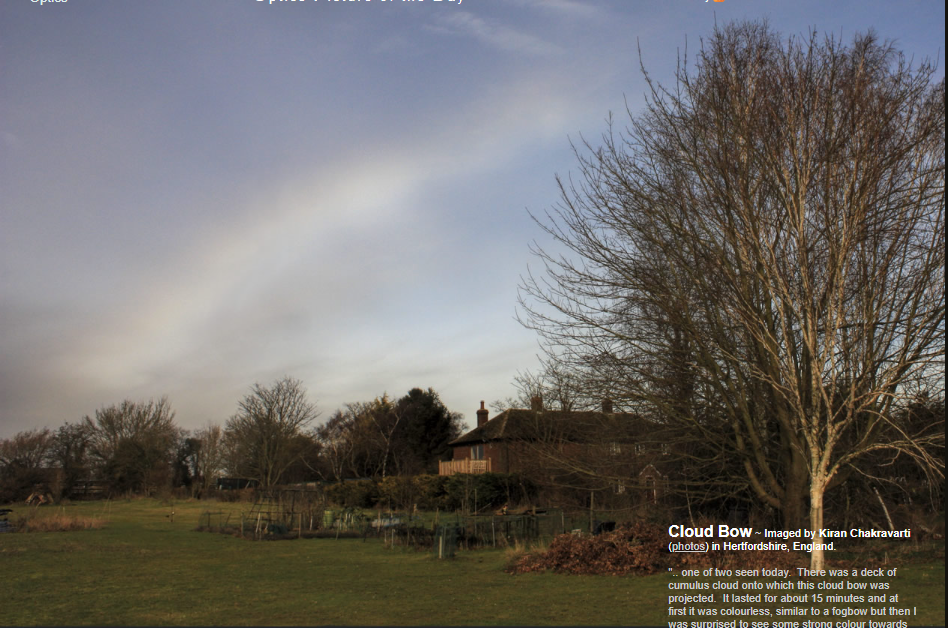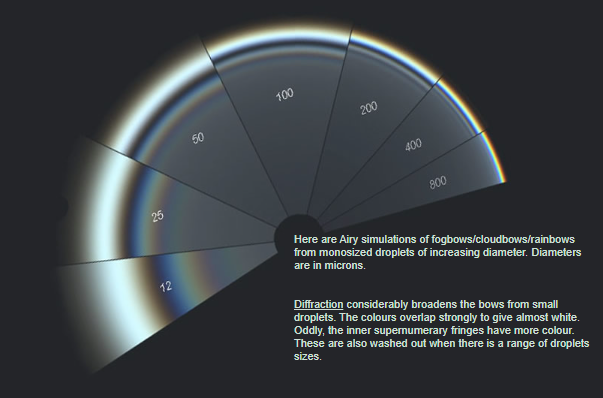Cloud Bow - OPOD
Cloud Bow - A Rare Atmospheric Phenomenon
Cloud bows are a fascinating and relatively rare atmospheric optics phenomenon that often goes unnoticed. They can appear against the backdrop of low-contrast grey clouds or even in clear blue skies. While they may not be as well-known as their more vibrant counterparts like rainbows, cloud bows possess their own unique beauty.
These ethereal arcs are formed by the presence of small water droplets suspended in damp air or by the occurrence of virga, which refers to fine rain that evaporates before reaching the ground. The size of these water droplets plays a crucial role in determining the appearance of the cloud bow. Depending on their size, these bows can range from broad and almost white to narrower with distinct rainbow colors.
When the droplets are small, diffraction effects come into play, causing the cloud bow to appear considerably broader. As a result, the colors of the bow overlap strongly, creating an almost white appearance. Interestingly, the inner supernumerary fringes, which are additional faint bands of color inside the main bow, tend to exhibit more vibrant hues. However, when there is a range of droplet sizes, these inner fringes may become washed out.
Cloud bows often possess a subtle beauty that requires keen observation to fully appreciate. Here are some key points to help you understand and recognize these elusive atmospheric phenomena:
-
Formation: Cloud bows are formed when sunlight interacts with water droplets suspended in the air or virga. The droplets act as tiny prisms, bending and dispersing light to create the bow-shaped arc.
-
Size and Shape: The size of the water droplets determines the appearance of the cloud bow. Larger droplets result in a more rainbow-like appearance, while smaller droplets produce broader and paler bows.
-
Coloration: Cloud bows can exhibit a range of colors, including reds, blues, and greens. The colors become more pronounced as the droplet size increases. However, the overall coloration of the bow can be subtle and easily overlooked.
-
Visibility: Cloud bows are often overlooked due to their low contrast against the background clouds or sky. They can be particularly challenging to spot in grey conditions. It takes a keen eye and awareness to notice these delicate phenomena.
-
Duration: Cloud bows tend to be relatively short-lived, lasting anywhere from a few minutes to around 15 minutes. Their transient nature adds to their allure and makes capturing them on camera a rewarding challenge.
-
Location: Cloud bows can occur in various locations around the world. They are not restricted to specific geographical regions or climates. However, they are more likely to appear in areas with a higher concentration of water droplets in the air, such as near bodies of water or during periods of high humidity.
-
Rare Occurrence: While cloud bows are not as commonly observed as rainbows, they are still a relatively rare phenomenon. Their subtle appearance and fleeting nature contribute to their rarity and make them a special sight for those fortunate enough to witness them.
-
Photography Tips: Capturing the delicate beauty of a cloud bow can be challenging but immensely rewarding. To photograph a cloud bow, it is important to use a polarizing filter to reduce glare and enhance color saturation. Additionally, adjusting the exposure settings to capture the subtle hues and delicate details can help create stunning images.
-
Similar Phenomena: It is essential to distinguish cloud bows from other atmospheric optical phenomena. Fogbows, for example, are similar to cloud bows but lack the distinct colors and are often white or pale in appearance. Understanding the unique characteristics of each phenomenon can help identify and appreciate their individual beauty.
-
Appreciating Nature's Wonders: Cloud bows remind us of the intricate and awe-inspiring beauty that can be found in the natural world. Taking the time to observe and appreciate these subtle phenomena can deepen our connection with nature and foster a sense of wonder and curiosity.
In conclusion, cloud bows are a captivating and relatively rare atmospheric optics phenomenon that deserves more attention. Their delicate appearance and subtle coloration make them a sight worth appreciating. By understanding the factors that contribute to their formation and recognizing their unique characteristics, we can enhance our appreciation for these elusive wonders of the sky. So, keep your eyes to the skies and embrace the beauty of cloud bows when you have the opportunity to witness them.

Cloud Bow ~ Imaged by Kiran Chakravarti (photos) in Hertfordshire, England.
".. one of two seen today. There was a deck of cumulus cloud onto which this cloud bow was projected. It lasted for about 15 minutes and at first it was colourless, similar to a fogbow but then I was surprised to see some strong colour towards the red end of the spectrum. You can also see some faint blues and greens." ©Kiran Chakravarti, shown with permission
Cloud bows are rare and perhaps more so because they are easily overlooked. They can appear in low contrast against grey cloud and even blue skies.
They are formed by small water droplets suspended in damp air or sometimes by virga, fine rain that evaporates before reaching the ground.
Depending on the droplet size they can range from almost white and broad to narrower with increasing rainbow colours. The larger the droplets the closer in appearance to a rainbow.

Here are Airy simulations of fogbows/cloudbows/rainbows from monosized droplets of increasing diameter. Diameters are in microns.
Diffraction considerably broadens the bows from small droplets. The colours overlap strongly to give almost white. Oddly, the inner supernumerary fringes have more colour. These are also washed out when there is a range of droplets sizes.
Note: this article has been automatically converted from the old site and may not appear as intended. You can find the original article here.
Reference Atmospheric Optics
If you use any of the definitions, information, or data presented on Atmospheric Optics, please copy the link or reference below to properly credit us as the reference source. Thank you!
-
<a href="https://atoptics.co.uk/blog/cloud-bow-opod/">Cloud Bow - OPOD</a>
-
"Cloud Bow - OPOD". Atmospheric Optics. Accessed on April 20, 2024. https://atoptics.co.uk/blog/cloud-bow-opod/.
-
"Cloud Bow - OPOD". Atmospheric Optics, https://atoptics.co.uk/blog/cloud-bow-opod/. Accessed 20 April, 2024
-
Cloud Bow - OPOD. Atmospheric Optics. Retrieved from https://atoptics.co.uk/blog/cloud-bow-opod/.